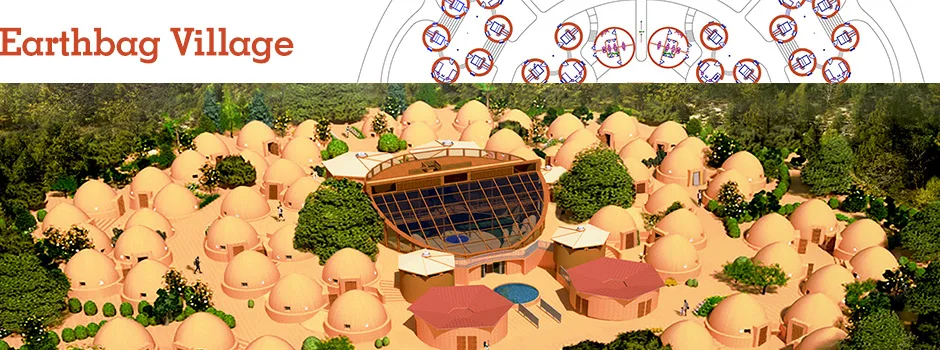
Earthbag Municipal/County Involvement and Permitting
Welcome to the Earthbag Village municipal/county involvement and permitting hub. This page explains the preparation for obtaining proper building permits for an earthbag structure, carried out through the local building department of the municipality/county of your location. Once we’ve finished this tutorial and open sourced all the details for the 3-dome cluster as part of our crowdfunding campaign, we’ll do the same for the complete Earthbag Village (Pod 1) and Duplicable City Center®, and then the other 6 villages.
This page contains the following sections:
NOTE: THIS PAGE IS NOT CONSIDERED BY US TO BE A COMPLETE AND USABLE TUTORIAL UNTIL
WE FINISH THE CROWDFUNDING CAMPAIGN AND ADD ALL THE VIDEOS AND EXPERIENCE FROM
THAT BUILD TO THIS PAGE – IN THE MEANTIME, WE WELCOME YOUR INPUT AND FEEDBACK
HERE ARE LINKS TO WHO WE ARE AS AN ORGANIZATION (click icons for complete pages)
VISIT THESE DETAILED PAGES FOR MORE ON THE COMPLETE VILLAGE PLANS (click icons)
CLICK THESE ICONS TO JOIN US THROUGH SOCIAL MEDIA
WHAT IS COUNTY INVOLVEMENT
![]() Any owner/authorized agent intending to build must abide by the local and municipal county codes (in our case the 2012 International Building Code) and obtain the required permits before initiating construction. County collaboration is mandatory in most areas unless you are out of their jurisdiction. This ensures compliance with occupant and structural safety codes, urban and rural development codes, environmental concerns, zoning regulations and other related aspects.
Any owner/authorized agent intending to build must abide by the local and municipal county codes (in our case the 2012 International Building Code) and obtain the required permits before initiating construction. County collaboration is mandatory in most areas unless you are out of their jurisdiction. This ensures compliance with occupant and structural safety codes, urban and rural development codes, environmental concerns, zoning regulations and other related aspects.
WHY CARE ABOUT COUNTY INVOLVEMENT
![]() The Primary reason to care about county involvement is for your safety and the safety of all who will be affected during and after your construction. Existing codes have been prepared by professionals who are exceptionally educated and experienced. Through testing and experience, they have arrived at the best and safest methods of construction. These “best practice” methods and codes have been designed to account for as many factors and scenarios as possible. The County and Municipality ensures these precautionary measures and codes are adhered to and help assure the education, training, and experience of others is carried forward for the maximum benefit of each project within their jurisdiction.
The Primary reason to care about county involvement is for your safety and the safety of all who will be affected during and after your construction. Existing codes have been prepared by professionals who are exceptionally educated and experienced. Through testing and experience, they have arrived at the best and safest methods of construction. These “best practice” methods and codes have been designed to account for as many factors and scenarios as possible. The County and Municipality ensures these precautionary measures and codes are adhered to and help assure the education, training, and experience of others is carried forward for the maximum benefit of each project within their jurisdiction.
The first thing to do after you have acquired a property and plan on constructing a structure is to talk to your local county so they can guide you through the process. They know the codes and are there to help you maintain a safe process as you build the best and safest way possible.
WAYS TO CONTRIBUTE TO EVOLVING THIS SUSTAINABILITY COMPONENT WITH US
SUGGESTIONS | CONSULTING | MEMBERSHIP | OTHER OPTIONS
CONSULTANTS ON THIS COMPONENT
Ashwini Ramesh: Civil Engineer and Project Manager
Hannah Copeman: Structural Engineer
WHAT TO BRING AND WHAT TO EXPECT
Before beginning your build, you will need to get approval from your county and local officials that what you are planning is safe and meets the local environmental and zoning regulations. From your first interaction, you will be building your relationship with the municipal/county team of people who can help you most to succeed. You will communicate with them frequently, and they are there to help you, so get to know them and help them to get to know you.
The following areas are discussed here to help you:
- A Positive and Cooperative Attitude
- Application & Fees
- Construction Drawings and Other Relevant Information
- Geotechnical and Soil Reports (if necessary)
- Building Permits
- Inspections by Building Officials
A POSITIVE AND COOPERATIVE ATTITUDE
 A positive and cooperative attitude are two of the most important things to bring to any team project. Building a sustainable structure is something most everyone has less experience with than traditional structures, so that makes builds like this even more of a team project than a regular build. With this in mind, being prepared, professional, and making friends with your county/municipality team is arguably the single most important thing you can do for the success of your project.
A positive and cooperative attitude are two of the most important things to bring to any team project. Building a sustainable structure is something most everyone has less experience with than traditional structures, so that makes builds like this even more of a team project than a regular build. With this in mind, being prepared, professional, and making friends with your county/municipality team is arguably the single most important thing you can do for the success of your project.
The codes, regulations, and entire building process may feel overwhelming and tedious at times, but the county/municipality team are there to help you. The codes are there to make sure everything is built safely and the county/municipality team are there to help with the understanding, implementation, and adherence to the codes. Together, the codes and the county team can literally make the difference between safety and non-safety, life and death in the worst case scenario, and a structure that will last for generations versus a structure that could completely deteriorate due to a totally avoidable structural problem or flaw.
We recommend your first interaction with your county/municipality be a call to find out what you need to bring with you for your first actual meeting. First impressions are lasting impressions, so use your very first call to start building your relationship with these people who can help you. Be patient and understanding while keeping a positive attitude in your interaction with the local authorities, their job is typically a thankless one and the complexity of what they do, and the number of challenges they address each day, can be huge.
Keep in mind also that earthbags may be a new concept to them, and this may mean added complexity and challenges that they aren’t used to. So prepare for their queries (by going through the extensive documentation available here on the website) and be as helpful and cooperative as you can while asking for their help and cooperation too. This will enhance comprehensive solutions and understanding for everyone involved and lead to faster and better answers to the difficult questions you can expect to ask.
APPLICATION AND FEES
The application is available from your local city/county building department and is the formal form submitted to acquire a building permit. It needs to be duly filled and applicable fees paid as instructed by the county. It will most likely ask for:
- Details about the owner of the property
- The construction location
- The type of construction
- Detailed construction drawings
Additional clearances from the Fire Department, environmental authorities, or others may be necessary too. Each will most likely have it’s own application and fees. The local county team is there to assist you, educate you, and help you obtain all you need. If you prefer professional help coordinating with the county, a local contractor is the person to hire. Any architects and/or engineers involved in your project can also be helpful completing the necessary details.
Depending on your county’s preference, associated fees may or may not be paid at the Application phase. All counties will require you to pay all the fees and dues before you obtain the permit though. Common fees include Plan Check, Processing Fees, Inspection Costs, and any other expenses that may be incurred by the county directly or indirectly in order to issue your building permit.
CONSTRUCTION DRAWINGS AND OTHER RELEVANT INFORMATION
The construction drawings are the complete plans for your build. They will include your
- Site/Plot Plan: An architecture, engineering, and/or landscape architecture plan drawing/diagram which shows the buildings, utility runs, and equipment layout, the position of roads, and other constructions of an existing or proposed project site at a defined scale
- Floor Plan: The scale diagram of the arrangement of rooms and other internal details of your structure
- Elevations and Sections: A vertical-plane view of the outside of the building and vertical-plane views cutting through the building
- Electrical Plan: Your plan for power, lighting, and communication within your structure
- Plumbing Plan: Drawings which describe piping systems that supply water to and drainage of waste materials from your structure
These plans will need to be checked and “stamped” as correct by a licensed professional registered in your jurisdiction according to the requirements established by local authorities. If you don’t know who to have help you with this, talk to your county for a referral.
Once you submit your plans (with proper fees), they will be reviewed by the county for safety and clarity. The county will then tell you any changes you need to incorporate and/or note for inclusion in the construction process.
GEOTECHNICAL AND SOIL REPORT
A geotechnical and soil report is a soil and subsoil investigation to determine the existing soil type and profile and the influencing factors that may warrant additional stabilization for (in our case) the footer/foundation. The report will include details regarding groundwater table depth, soil/rock profile type, geological formations, etc., all of which can have an impact on the design process.
Your county will let you know if you need this report. It is more commonly requested for larger multi-story structures and likely will not be required for simpler single-story buildings like yours. If it turns out that it is requested for your build though, it is important to have so you can identify if additional precautionary measures are required to insure a safe and stable structure.
All this said, even if a soil report isn’t requested by your county, it can be especially good to have these reports during an earthbag build since the soil is your primary building material. An analysis will give you the clearest picture on the type of soil you have and this will be what you use to decide if you need to add an additional stabilizing component such as lime or cement.
TESTING YOUR OWN SOIL
You can also test your own soil to determine its composition and whether or not you’ll need an additional stabilizing component such as lime or cement. It is a simple 3-step process:
Step 1: Wet and knead soil
Step 2: Can the soil form a ball?
Step 3: Does the soil ribbon?
Here are two videos describing this process in detail:
BUILDING PERMITS
Building permits grant permission for you to start, build, and occupy the structure. This process occurs in stages that are supervised by building officials provided by your county. The goal of the permits and each stage of the permitting process is to ensure the safety of the structure, everyone involved in the construction, and everything surrounding the construction that will be directly or indirectly affected by it.
When you get your permit, it will usually come in the form of paper approval signed and sealed by the County Authority. It will clearly describe what the permit is for, what location and structure the permit applies to, and any other important details for the extent of the permit.
Some types of structures like greenhouses, storage sheds, etc. may not need a building permit in some counties. If this is the case in your county, they will be able to tell you the specifics of what is necessary to classify something as a “greenhouse” or “shed.” Use and size are common criteria for classification as a structure that doesn’t need to be permitted. Limitations on conveniences normally contained in living structures (running water, electricity, etc.) can often be included too. This is because living structures in the U.S. always (to our knowledge) need to be permitted, and many counties seek to maximize safety of all structures with these kinds of limitations that make non-permitted structures less livable.
As mentioned throughout this section, working with your county officials and getting proper permits is in your best interest because they are important for your safety and the safety of your structure. County/municipality officials responsible for permitting know this more than anyone and are there to help you understand the complete process and reasons for each permit. They are also there to make sure all projects are compliant, starting a project that requires a permit without acquiring one is a violation of the law and can have serious consequences. If you are curious what those consequences are, your county can answer those questions too.
INSPECTION BY BUILDING OFFICIALS
Inspections are done at various stages of construction and you will be responsible to schedule these with the proper officials. Remember that these people are there to make sure what you are building is safe for you and others, so use your first conversation or meeting to start building a positive relationship. During your inspections the building official will check for approved plans and permits, inspect if there is any deviation from the approved plan, and inform you of any corrections needed.
Your county/municipality will give you instructions about when the inspections are necessary and what you need for each one. It is important for you to make note of those milestones and set up an appointment prior to any aspect of construction that would hinder an inspection. Closing walls, floors, ceilings, burying aspects of the project, etc. are all examples of construction that you want to be sure are only completed after necessary inspections have been conducted and signed off. This is important because covering an area before a necessary inspection will mean you have to reopen/uncover that area for the inspection and then redo it. This is an easily avoidable waste of resources, time, and energy if you make certain to get your inspections as directed by our county.
BUILDING POSITIVE RELATIONSHIPS
 As we’ve already said, one’s personal interaction with local authorities is arguably one of the most important factors for moving your project along. Consider a single individual to act as the liaison for creating harmonious relationships that demonstrate a willingness and patience to work together, mutual respect, and effective communication. The importance of this cannot be overemphasized. The less you know about construction, terminology, etc., the more you will want to build positive relationships with those who can help you most. Conversely, the more you know about and/or familiarize yourself with technical terminology, construction goals, etc., the easier it will be for you to communicate and work with these professionals. Without the personal side or the related experience, the less likely officials will go out of their way to accommodate the project needs or alternative solutions to unexpected predicaments. This can hamper your overall progress and possibly bring your project to a standstill or a complete dismissal.
As we’ve already said, one’s personal interaction with local authorities is arguably one of the most important factors for moving your project along. Consider a single individual to act as the liaison for creating harmonious relationships that demonstrate a willingness and patience to work together, mutual respect, and effective communication. The importance of this cannot be overemphasized. The less you know about construction, terminology, etc., the more you will want to build positive relationships with those who can help you most. Conversely, the more you know about and/or familiarize yourself with technical terminology, construction goals, etc., the easier it will be for you to communicate and work with these professionals. Without the personal side or the related experience, the less likely officials will go out of their way to accommodate the project needs or alternative solutions to unexpected predicaments. This can hamper your overall progress and possibly bring your project to a standstill or a complete dismissal.
To establish the most positive and beneficial relationship for all, the contact person for your project must establish a consistent and open relationship that demonstrates integrity as its foundation. Cutting corners and trying to circumvent building standards can significantly damage or completely ruin your relationship with your county and its officials. Openly communicate via phone during the planning process and take notes on your conversations, while also obtaining names, contacts, and best times to follow up with further inquiries. Make an attempt to create a genuine professional relationship with the building inspector, county commissioners, and/or whomever you have interaction. Some are easier to communicate with than others, but if you are friendly and open from the start, that will set you off on the proper path and lend success to your project.
Remember that you may think you have all the answers, but remain open to their suggestions. Generally, if you are demonstrating cooperation others will make themselves more available to assisting you in finding solutions while keeping your project on schedule. Expect also that you may work with some authorities who have little to no experience with earthbag construction. In these cases, it is your responsibility to educate them on the various aspects of the project and you must back up your plans with engineering approval in the earlier part of your planning. With a licensed engineer’s approval the building inspector will be more willing and may even be eager to learn more about your project. The more interaction between the two of you, the more this facilitates forward progression.
Once on site, if you have already established a cordial and professional working relationship, the continued cooperation will fall into place. At some point you may be unavailable during the process and you will want to have a backup person to fill in for you. It is a good idea to introduce this person to the authorities ahead of time. Have them come to a couple of your meetings so that, when the time arrives, the familiar face at the next encounter you are unable to attend will be welcomed and not scrutinized.
VIDEO COMING OF: ROUNDTABLE DISCUSSION ON BUILDING POSITIVE COUNTY RELATIONSHIPS
SEE OUR HOW TO HELP AND/OR CROWDFUNDING CAMPAIGN PAGE TO HELP CREATE ALL THE TUTORIAL VIDEOS FASTER
MUNICIPALITY/COUNTY INVOLVEMENT
 Some areas where you build will be under local code jurisdiction and others will not. If you are required to obtain a building permit do so before any construction or excavation is performed. You will have to pay a fee to obtain the necessary permit(s). With the proper documents paid and signed you can then begin the construction process. The local building department will advise on plans, sequential order and adherence to guidelines, and inspection timelines. Your project will be progressively inspected so exercise caution in the order of your tasks so you do not have to go back and redo work that has been covered up and made inaccessible by subsequent work. For example, do not cover up the plumbing, electrical, and insulation with drywall until the inspector has inspected and signed off those particular phases of work. Failure to do so may result in opening up walls and uncovering completed work, causing setbacks in both time and resources.
Some areas where you build will be under local code jurisdiction and others will not. If you are required to obtain a building permit do so before any construction or excavation is performed. You will have to pay a fee to obtain the necessary permit(s). With the proper documents paid and signed you can then begin the construction process. The local building department will advise on plans, sequential order and adherence to guidelines, and inspection timelines. Your project will be progressively inspected so exercise caution in the order of your tasks so you do not have to go back and redo work that has been covered up and made inaccessible by subsequent work. For example, do not cover up the plumbing, electrical, and insulation with drywall until the inspector has inspected and signed off those particular phases of work. Failure to do so may result in opening up walls and uncovering completed work, causing setbacks in both time and resources.
Expect your municipality/county Building Department to closely monitor the following:
APPROVED PLANS AND DRAWINGS
Your plans require the stamp of an engineer who is licensed in the state of your location. The engineer may reside in another state yet remain licensed in multiple states. Currently there are not many who have any earthbag experience, but the engineer can run and confirm any necessary calculations to determine the integrity or effectiveness of any portion of the project. If at all possible, find yourself an engineer who has a genuine interest in this type of project, or at least demonstrates enough curiosity to desire involvement.
One Community is sharing all of our plans, permits, and design process to help you. As we complete them, they will be available through the Building Plans and Files pages of each of the open source hubs. Look for icons like this:
DEVIATIONS
Deviations are actions taken outside your approved plans. The building department will review your work to assure adherence to code and that you are following the approved plans; be certain those performing the work are briefed on exact specifications. Any deviation and code violation will be noted and you are responsible to correct that violation until the authorities are satisfied and sign off on that particular segment of work.
Again, having established a positive relationship with the county can make a huge difference here in how helpful they are when you make mistakes and need to correct them. If you have no prior construction experience, having members on your team with experience and knowledge of proper construction techniques and code issues beforehand is also extremely helpful. This will reduce accidental deviations, enhance your entire project experience, and provide an increased professional foundation that will add to the educational value and enjoyment of your entire project.
TIME AND WORK RECOMMENDATIONS
The authorities can offer a timetable of the order of inspections and what work is necessary to have complete before each one. Be on good terms with your inspectors and demonstrate professionalism, cooperation, and your desire to work within the system. This is important for your safety, the safety of your work site, and the safety of your building. In the case of non-safety related code details, an inspector who appreciates your cooperation and project can also sometimes be more lenient on your behalf.
RESOURCES
- International Building Code – 2012
- Earthbag Building Code Reference – Arizona
- Avoidance Approach: This podcast shares Glenn Kangiser’s experience building this without permits
- Use this page (click here) if you have a resource you’d like to suggest be added here
SUMMARY
![]() Municipality/county involvement occupies a major role with your construction project from start to finish. If you build positive relationships from the beginning, maintain constant contact and communication with your county/municipality, and abide by the established rules, you will, with pride, create a safe structure and enjoy a cooperative and fulfilling learning experience that can be shared and passed on to others.
Municipality/county involvement occupies a major role with your construction project from start to finish. If you build positive relationships from the beginning, maintain constant contact and communication with your county/municipality, and abide by the established rules, you will, with pride, create a safe structure and enjoy a cooperative and fulfilling learning experience that can be shared and passed on to others.
FREQUENTLY ANSWERED QUESTIONS
Q: What documents must I have in possession before initiating construction?
Check that you have all required documents as mentioned in the application form. This will vary from one jurisdiction to another but here is a general listing of what most can expect to need:
- Application forms duly completed and signed along with necessary fees
- Ownership documentation (registered deed)
- Detailed construction drawings stamped and signed by an engineer
- Cost estimate
- Geotechnical analysis (more common for larger structures)
Q: How well-versed must I be with the International Building Codes?
You do not have to understand the International Building Code if you have a Professional Engineer (PE) that has reviewed your plans. It is important though that you bring any code concerns or curiosities to the attention of the engineer you are working with. This person will have a much stronger grasp of the codes because it is their profession and professional duty to understand and apply the codes properly. If something is amiss, the local authorities will question and ask for definitive proof regarding safe procedural norms. Your responsibility is not to know all the codes, but to have qualified input from experienced professionals who sort that out as part of the pre-build process.
Q: What are the common permits and certificates required before construction?
- Building Permit: This is a general construction permit issued after a site inspection and approval of your drawings by the building inspector. This permit allows initiation of construction according to the proper building codes and should be placed in a visible location on site
- Phased Inspections: The ensuing phased inspections are then initialed on this same document (the Building Permit) and will include footer/foundation, framing, electrical, plumbing, drywall, fire safety, etc.
- Certificate of Occupancy (CO): When building requirements have been satisfied and signed off, the CO is issued and allows usage as intended/permitted for the structure
Q: It is much easier and less expensive to build without a permit, what are the advantages of working within the bureaucracy?
You might save money and yes it might be easier in the short term, but there are valid reasons for going through the permitting process. Safety is the major reason as well as creating a building that is structurally sound and long lasting. Most people engaging in their initial build find that the authorities serve a valuable purpose and are a beneficial resource and asset to their project.
Q: Are all the codes/regulations the same?
No, codes vary from county to county, state to state, and country to country. For this very reason it is very difficult to know the codes and another reason to operate within the existing system that is intended to work for both you and your county/municipality. There is no easy way to generalize other than being aware of the process and/or hiring a 3rd-party liaison (like the engineer/architect involved in your project) to assist in code adherence.
Q: If codes are supposed to be the safest and best way to do things, why do they differ in different places?
The governing bodies of a location determine the codes for that location. Some places prefer to keep the code sets they’ve been using for a long time and others find themselves moving to a more standardized building code like the International Building Code.
 One Community
One Community












